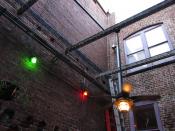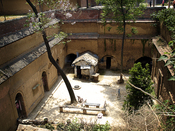The first primitive Chinese sunken courtyard dwelling dates back to around 2000 B.C. in the provinces of Shaanxi and Shanxi, China by most of the Jiaxian County. It is been known that these underground housings precedes the houses built above ground. Even after 4 millenniums, there is still around an estimated 30-40 million Chinese who lives in these shelters today and are confined to the region along the Yellow River in Northern China. The yellow earth, also known as "loess soil" of this region is structurally uniform and free of stone, plants, and trees. This presents an ideal condition for easy digging and stable form of foundation. The notable sunken courtyards are a large square or rectangular pit dug in about 10 meters deep with arched cave dwelling units dug around the perimeter.
The scarcity of rain had made the provinces of Shaanxi and areas of northwest China extremely arid and dry.
Despite of its supposed inhabitability, people did live there generations amongst generations through thousands of years. Considering that an area short of rain, timber, stone and fuel utilized in baking bricks, with extreme cold winds and sandstorms, it is of no surprise the Chinese chose to dig a sunken courtyard to be their shelter and home. The cave rooms that branches off from the courtyard insulated heat during long, cold winters and also remain fairly cool in the summer. One of the difficulties that they dealt with was when it did rain, there was a heavy downpour. The courtyards would accumulate the rain and a potential flood might occur. To solve this problem they built a drainage system that left through the exterior of the structure.
Cave-type dwellings such as the sunken courtyards make ideal settings for the traditional extended Chinese family structure. The traditional patriarchal family, with...


